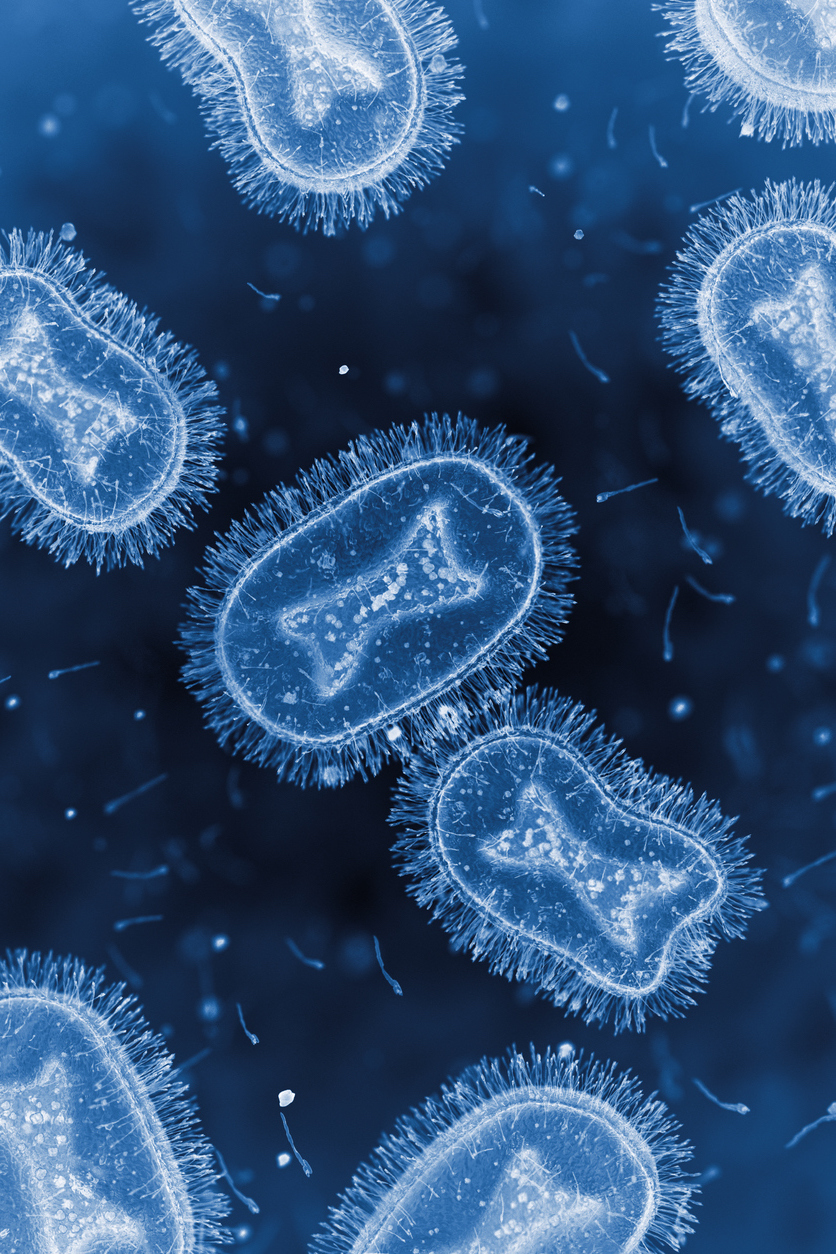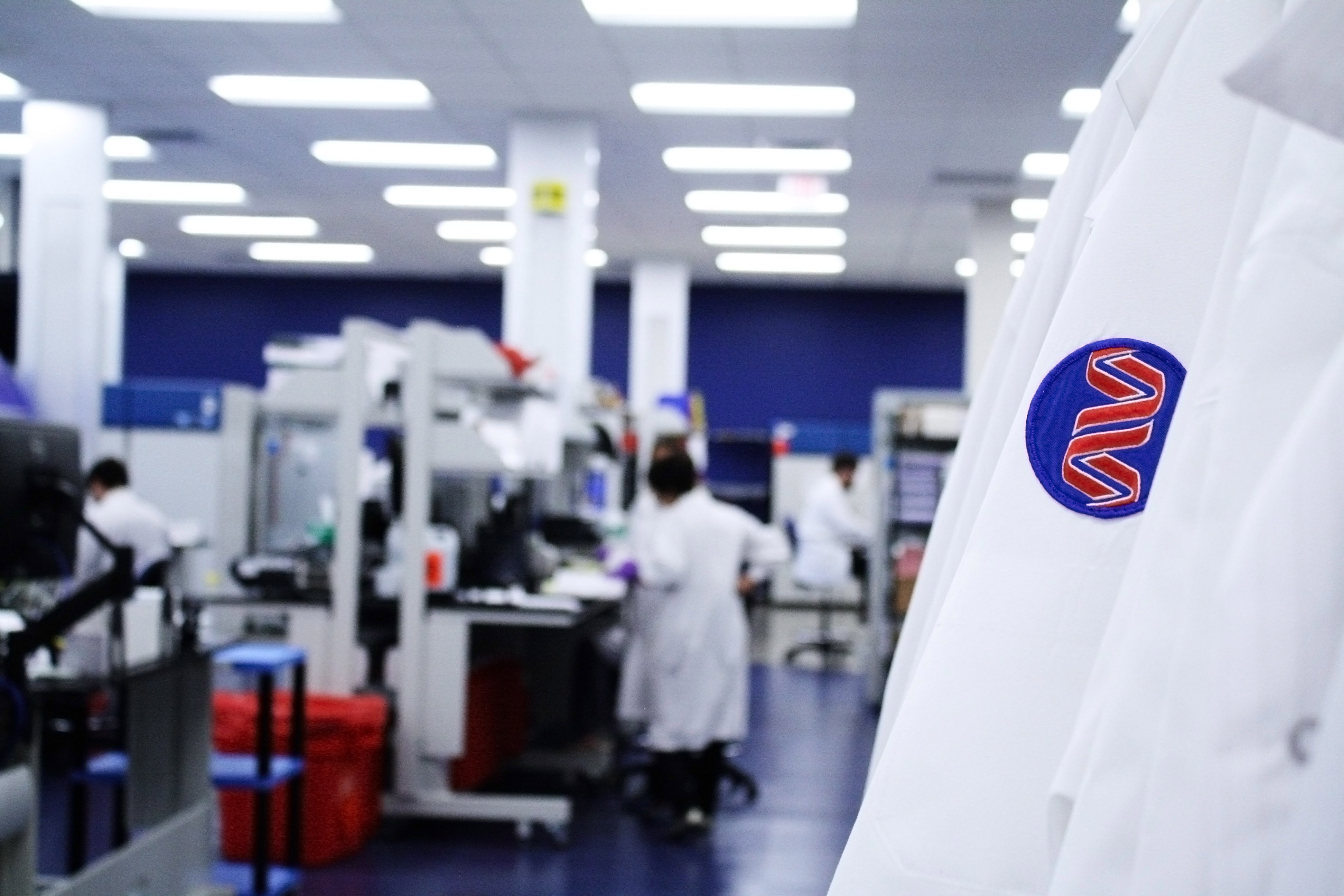Disease Overview
Mpox is a zoonotic disease caused by mpox virus, an enveloped double-stranded DNA virus that belongs to the Orthopoxvirus genus. Other clinically important viruses of the Orthopoxvirus genus are variola virus (the causative agent of smallpox), vaccinia virus (used in the smallpox vaccine), and cowpox virus. Mpox was first identified as the causative agent of two pox-like disease outbreaks in monkey colonies housed for research in 1958. Although the exact natural host remains unknown, the mpox virus has been isolated from rope squirrels, tree squirrels, Gambian pouched rats, dormice, non-human primates, and other species.
Transmission and Incubation Period
Animal-to-human transmission of mpox virus occurs through direct contact with the blood, bodily fluids, or cutaneous or mucosal lesions of infected animals. Human-to-human transmission typically occurs through contact with infectious respiratory secretions, skin lesions of an infected person or recently contaminated objects. Most cases in the current outbreak have been identified in men who have sex with men, leading to the possibility that mpox can be transmitted through sexual transmission routes. Transmission can also occur through contact with materials or fomites (e.g. clothing or linens) that have been contaminated with bodily infectious materials. Transmission has also been reported via droplet respiratory particles, via the placenta from mother to fetus or via close contact during and after childbirth.
The incubation period of mpox can be 5 to 21 days but typically ranges from 6 to 13 days. The disease manifestation can be divided into two periods:
Invasion Period
The initial prodromal/invasion period is characterized by fever, intense headache, lymphadenopathy, back pain, myalgia and intense asthenia within 5 days of infection.
Rash/Skin Eruption
The rash/skin eruption usually occurs within 1 to 3 days of the appearance of fever and continues for a period of 2 to 3 weeks. The rashes are usually concentrated on the face and extremities (palms of the hands and soles of the feet). Other affected sites may include oral mucous membranes, genitalia, and conjunctivae, as well as the cornea. The rash progresses successively from macules to papules, vesicles, pustules, and crusts that dry up and fall off. The number of lesions can be highly variable, from a few to several thousand. In severe cases, lesions can coalesce until large sections of skin slough off.
The disease is generally self-limiting and the symptoms last from 2 to 4 weeks. An individual remains infectious from the onset of illness until all lesions have scabbed over and re-epithelialization has occurred. Complications of mpox can include secondary infections, bronchopneumonia, sepsis, encephalitis, and infection of the cornea with ensuing loss of vision. Severe cases and complication may occur in children and immunocompromised hosts. Asymptomatic infections have been documented but the frequency/prevalence of asymptomatic infections is unknown.
About Our Test

Sonic Reference Laboratory's Monkeypox Virus by PCR test methodology is real-time PCR utilizing the CDC Non-variola Orthopoxvirus Real-time PCR Primer and Probe Set. The assay detects non-variola Orthopoxvirus DNA in clinical specimens. Although this assay does not differentiate mpox virus from other Orthopoxvirus including vaccinia, cowpox, camelpox, ectromelia or gerbilpox virus, a positive result with this assay in the United States is most likely due to mpox virus; however, potential exposure to other Orthopoxviruses should be considered. The test results are intended to be utilized in conjunction with clinical presentation, epidemiological data, other diagnostic test results, and vaccination and exposure history. As mpox virus infections can present with rashes/lesions similar to that of varicella zoster virus, herpes simplex virus, and other sexually transmitted infections, consider testing for other pathogens as clinically indicated.
Test Ordering Information
Test Information
| Order Code: | Contact your laboratory partner |
| Test Name: | MONKEYPOX VIRUS PCR |
| Ordering Recommendation: | For detection of non-variola Orthopoxvirus, including mpox virus, DNA in clinical specimens |
| Test Contains (LOINC): |
Monkeypox Virus PCR (100434-0), Specimen Type (31208-2), Source Site (39111-0), Symptomatic (95419-8), Symptom Onset Date (11368-8) |
Specimen Requirements
| Sample Type: | Swabs from skin lesion |
| Preferred Container: |
Sterile leak-proof screw cap tube preferably with O-ring or gasket seal |
| Alternate Container: |
Swabs in viral transport medium (VTM) |
| Sample Volume: | Two swabs |
| Handling Instructions: | Collect two swabs from each lesion. Swab 2-3 lesions from different parts of the body or lesions with differing appearance. Do NOT collect and submit swabs from more than 3 lesions. Vigorously swab or brush active lesion with two separate sterile synthetic swabs (e.g. Dacron, polyester, or nylon) with a plastic shaft and breakpoint close to the tip. Do NOT use cotton swabs. Break off or cut the tip of each swab into a sterile tube or tube with 1 mL of VTM. Each swab should be placed in a separate tube or container. Parafilm may be used to ensure a leak-proof lid if the tube does not have an O-ring or gasket seal. The length of the swabs after breaking or cutting should be no longer than 35mm (1.5 in.). Do NOT add transport media to specimens intended to be shipped as dry swabs. Refrigerate or freeze specimen immediately after collection. Freezing is strongly recommended. To maintain optimum specimen viability, transport the specimen to the laboratory as soon as possible. |
| Transport: | Frozen on dry ice |
| Specimen Stability: | Refrigerated: 7 Days; Frozen: 1 Month |
| Unsuitable Specimen: | Swabs from more than 3 lesions. Single swab. Cotton swabs. Swabs with wooden or metal shafts. Swabs in transport media other than VTM. Out of stability specimens. Ambient specimens. |
Testing Details
| Frequency: | Monday, Tuesday, Wednesday, Thursday, Friday |
| Expected Turn Around: | 2 - 3 Days |
| Reference Range: | Negative |
| Responsible Department: | Molecular |
| NYSDOH Approval Status: | Approved |
| CPT: | 87593 |
| Methodology: | Real-Time Polymerase Chain Reaction (RT-PCR) |
CDC Mpox Advisory Notice
CDC has alerted clinical laboratories performing Monkeypox virus (MPXV) testing of rare false-negative results when using laboratory developed tests (LDTs) with CDC’s published primers and probes. CDC reported identification of at least three MPXV cases in California with significant deletion in the tumor necrosis factor (TNF) receptor gene. CDC’s published primers and probes targets the TNF gene for detection of MPXV and differentiation of West African MPXV clade. For further information, refer to CDC’s Lab Alert.
Sonic Reference Laboratory’s Monkeypox Virus PCR (U590) test utilizes CDC’s 510(k) cleared Non-Orthopoxvirus Real-time PCR assay that detects the DNA of common non-variola Orthopoxvirus human pathogens, including Monkeypox viruses. Because this assay targets the essential poxvirus gene, E9L, SRL’s Mpox assay is unaffected by the mutation in the TNF gene reported in CDC’s Lab Alert. It is also noteworthy to emphasize that E9L is an essential gene, thus changes within the targeted sequence are less likely to occur.
For further details regarding specimen collection requirements, refer to Monkeypox Virus PCR (U590) on Sonic Reference Laboratory’s Test Collection Manual.
References:
- CDC’s Laboratory Outreach Communication System (LOCS): 09/02/2022: Lab Alert: MPXV TNF Receptor Gene Deletion May Lead to False Negative Results with Some MPXV Specific LDTs.
- Non-variola Orthopoxvirus Real-time PCR assay instructions.
References:
- US Monkeypox outbreak 2022. CDC’s 2022 U.S. Map & Case Count. https://www.cdc.gov/poxvirus/monkeypox/response/2022/us-map.html
- Global Monkeypox outbreak 2022. CDC. https://www.cdc.gov/poxvirus/monkeypox/response/2022/world-map.html
- KD Reed, et al., The detection of monkeypox in humans in the Western Hemisphere. N Engl J Med. 2004. 350, 342– 350. https://pubmed.ncbi.nlm.nih.gov/14736926/
- Sklenovská N, Van Ranst M. Emergence of Monkeypox as the Most Important Orthopoxvirus Infection in Humans. Front Public Health. 2018 Sep 4;6:241. https://www.ncbi.nlm.nih.gov/pmc/articles/PMC6131633/
- Monkeypox fact sheet. World Health Organization. https://www.who.int/news-room/fact-sheets/detail/monkeypox
- Laboratory Procedures and Biosafety Guidelines. CDC. https://www.cdc.gov/poxvirus/monkeypox/lab-personnel/lab-procedures.html
- Collection, Storage, and Shipment of Specimens for Monkeypox Diagnosis. CDC. https://www.cdc.gov/poxvirus/monkeypox/clinicians/prep-collection-specimens.html

